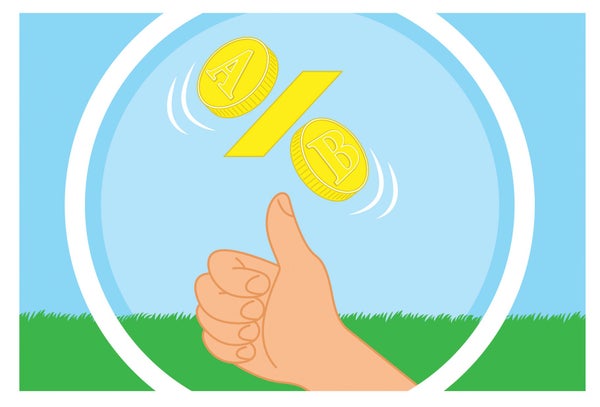The phrase “coin toss” is a classic synonym for randomness. But since at least the 18th century, mathematicians have suspected that even fair coins tend to land on one side slightly more often than the other. Proving this tiny bias, however, would require hundreds of thousands of meticulously recorded coin flips, making laboratory tests a logistical nightmare.
František Bartoš, currently a Ph.D. candidate studying the research methods of psychology at the University of Amsterdam, became intrigued by this challenge four years ago. He couldn't round up enough volunteers to investigate it at first. “Nobody was stupid enough to spend a couple of weekends flipping coins,” he says. But after he began his Ph.D. studies, he tried again, recruiting 47 volunteers (many of them friends and fellow students) from six countries. Multiple weekends of coin flipping later, including one 12-hour marathon session, the team had performed 350,757 tosses, shattering the previous record of 40,000.
The flipped coins, according to findings in a preprint study posted on arXiv.org, landed with the same side facing upward as before the toss 50.8 percent of the time. The large number of throws allows statisticians to conclude that the nearly 1 percent bias isn't a fluke. “We can be quite sure there is a bias in coin flips after this data set,” Bartoš says.
On supporting science journalism
If you're enjoying this article, consider supporting our award-winning journalism by subscribing. By purchasing a subscription you are helping to ensure the future of impactful stories about the discoveries and ideas shaping our world today.
The leading theory explaining the subtle advantage comes from a 2007 physics study by Stanford University statistician Persi Diaconis and his colleagues, whose calculations predicted a same-side bias of 51 percent. From the moment a coin is launched into the air, its entire trajectory—including whether it lands on heads or tails—can be calculated by the laws of mechanics. The researchers determined that airborne coins don't turn around their symmetrical axis; instead they tend to wobble off-center, which causes them to spend a little more time aloft with their initial “up” side on top.
For day-to-day decisions, coin tosses are as good as random because a 1 percent bias isn't perceptible with just a few coin flips, says statistician Amelia McNamara of the University of St. Thomas in Minnesota, who wasn't involved in the new research. Still, the study's conclusions should dispel any lingering doubt regarding the coin flip's slender bias. “This is great empirical evidence backing that up,” she says.
It isn't difficult to prevent this bias from influencing your coin-toss matches; simply concealing the coin's starting position before flipping it should do the trick. Alternatively, you can do away with flipping altogether by jiggling a coin between your curved palms. But if your friends are unaware of the tiny bias, you may as well benefit from your slight advantage. After all, 51 percent odds beat a casino's house advantage for six-deck blackjack. “If you asked me to bet on a coin,” Bartoš says, “why wouldn't I give myself a 1 percent bias?”
